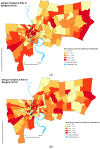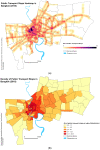Importance of Public Transport Networks for Reconciling the Spatial Distribution of Dengue and the Association of Socio-Economic Factors with Dengue Risk in Bangkok, Thailand
- PMID: 36011755
- PMCID: PMC9408777
- DOI: 10.3390/ijerph191610123
Importance of Public Transport Networks for Reconciling the Spatial Distribution of Dengue and the Association of Socio-Economic Factors with Dengue Risk in Bangkok, Thailand
Abstract
Dengue is the most widespread mosquito-borne viral disease of man and spreading at an alarming rate. Socio-economic inequality has long been thought to contribute to providing an environment for viral propagation. However, identifying socio-economic (SE) risk factors is confounded by intra-urban daily human mobility, with virus being ferried across cities. This study aimed to identify SE variables associated with dengue at a subdistrict level in Bangkok, analyse how they explain observed dengue hotspots and assess the impact of mobility networks on such associations. Using meteorological, dengue case, national statistics, and transport databases from the Bangkok authorities, we applied statistical association and spatial analyses to identify SE variables associated with dengue and spatial hotspots and the extent to which incorporating transport data impacts the observed associations. We identified three SE risk factors at the subdistrict level: lack of education, % of houses being cement/brick, and number of houses as being associated with increased risk of dengue. Spatial hotspots of dengue were found to occur consistently in the centre of the city, but which did not entirely have the socio-economic risk factor characteristics. Incorporation of the intra-urban transport network, however, much improved the overall statistical association of the socio-economic variables with dengue incidence and reconciled the incongruous difference between the spatial hotspots and the SE risk factors. Our study suggests that incorporating transport networks enables a more real-world analysis within urban areas and should enable improvements in the identification of risk factors.
Keywords: Bangkok; dengue; mobility; socio-economic risk; spatial clusters; transport system.
Conflict of interest statement
The authors declare no conflict of interest. The funders had no role in the design of the study; in the collection, analyses, or interpretation of data; in the writing of the manuscript, or in the decision to publish the results.
Figures








References
-
- WHO . Dengue and Dengue Hemorrhagic Fever, Fact Sheet 117. World Health Organization; Geneva, Switzerland: 2012. [(accessed on 5 March 2019)]. Revised February 2015. Available online: http://www.who.int/mediacentre/factsheets/fs117/en/
Publication types
MeSH terms
LinkOut - more resources
Full Text Sources
Medical

